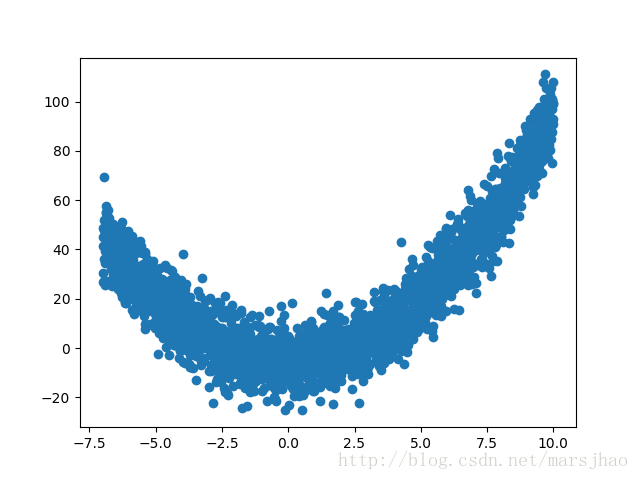一、bn(batch normalization)算法
1. 对数据进行归一化处理的重要性
神经网络学习过程的本质就是学习数据分布,在训练数据与测试数据分布不同情况下,模型的泛化能力就大大降低;另一方面,若训练过程中每批batch的数据分布也各不相同,那么网络每批迭代学习过程也会出现较大波动,使之更难趋于收敛,降低训练收敛速度。对于深层网络,网络前几层的微小变化都会被网络累积放大,则训练数据的分布变化问题会被放大,更加影响训练速度。
2. bn算法的强大之处
1)为了加速梯度下降算法的训练,我们可以采取指数衰减学习率等方法在初期快速学习,后期缓慢进入全局最优区域。使用bn算法后,就可以直接选择比较大的学习率,且设置很大的学习率衰减速度,大大提高训练速度。即使选择了较小的学习率,也会比以前不使用bn情况下的收敛速度快。总结就是bn算法具有快速收敛的特性。
2)bn具有提高网络泛化能力的特性。采用bn算法后,就可以移除针对过拟合问题而设置的dropout和l2正则化项,或者采用更小的l2正则化参数。
3)bn本身是一个归一化网络层,则局部响应归一化层(local response normalization,lrn层)则可不需要了(alexnet网络中使用到)。
3. bn算法概述
bn算法提出了变换重构,引入了可学习参数γ、β,这就是算法的关键之处:

引入这两个参数后,我们的网络便可以学习恢复出原是网络所要学习的特征分布,bn层的钱箱传到过程如下:

其中m为batchsize。batchnormalization中所有的操作都是平滑可导,这使得back propagation可以有效运行并学到相应的参数γ,β。需要注意的一点是batch normalization在training和testing时行为有所差别。training时μβ和σβ由当前batch计算得出;在testing时μβ和σβ应使用training时保存的均值或类似的经过处理的值,而不是由当前batch计算。
二、tensorflow相关函数
1.tf.nn.moments(x, axes, shift=none, name=none, keep_dims=false)
x是输入张量,axes是在哪个维度上求解, 即想要 normalize的维度, [0] 代表 batch 维度,如果是图像数据,可以传入 [0, 1, 2],相当于求[batch, height, width] 的均值/方差,注意不要加入channel 维度。该函数返回两个张量,均值mean和方差variance。
2.tf.identity(input, name=none)
返回与输入张量input形状和内容一致的张量。
3.tf.nn.batch_normalization(x, mean, variance, offset, scale, variance_epsilon,name=none)
计算公式为scale(x - mean)/ variance + offset。
这些参数中,tf.nn.moments可得到均值mean和方差variance,offset和scale是可训练的,offset一般初始化为0,scale初始化为1,offset和scale的shape与mean相同,variance_epsilon参数设为一个很小的值如0.001。
三、tensorflow代码实现
1. 完整代码
|
1
2
3
4
5
6
7
8
9
10
11
12
13
14
15
16
17
18
19
20
21
22
23
24
25
26
27
28
29
30
31
32
33
34
35
36
37
38
39
40
41
42
43
44
45
46
47
48
49
50
51
52
53
54
55
56
57
58
59
60
61
62
63
64
65
66
67
68
69
70
71
72
73
74
75
76
77
78
79
80
81
82
83
84
85
86
87
88
89
90
91
92
93
94
95
96
97
98
99
100
101
102
103
104
105
106
107
108
109
110
111
112
113
114
115
116
117
118
119
120
121
122
123
124
125
126
127
128
129
130
131
132
133
134
135
136
137
138
139
140
141
142
143
144
145
146
147
148
|
import tensorflow as tf import numpy as np import matplotlib.pyplot as plt activition = tf.nn.relu n_layers = 7 # 总共7层隐藏层 n_hidden_units = 30 # 每层包含30个神经元 def fix_seed(seed=1): # 设置随机数种子 np.random.seed(seed) tf.set_random_seed(seed) def plot_his(inputs, inputs_norm): # 绘制直方图函数 for j, all_inputs in enumerate([inputs, inputs_norm]): for i, input in enumerate(all_inputs): plt.subplot(2, len(all_inputs), j*len(all_inputs)+(i+1)) plt.cla() if i == 0: the_range = (-7, 10) else: the_range = (-1, 1) plt.hist(input.ravel(), bins=15, range=the_range, color='#ff5733') plt.yticks(()) if j == 1: plt.xticks(the_range) else: plt.xticks(()) ax = plt.gca() ax.spines['right'].set_color('none') ax.spines['top'].set_color('none') plt.title("%s normalizing" % ("without" if j == 0 else "with")) plt.draw() plt.pause(0.01) def built_net(xs, ys, norm): # 搭建网络函数 # 添加层 def add_layer(inputs, in_size, out_size, activation_function=none, norm=false): weights = tf.variable(tf.random_normal([in_size, out_size], mean=0.0, stddev=1.0)) biases = tf.variable(tf.zeros([1, out_size]) + 0.1) wx_plus_b = tf.matmul(inputs, weights) + biases if norm: # 判断是否是batch normalization层 # 计算均值和方差,axes参数0表示batch维度 fc_mean, fc_var = tf.nn.moments(wx_plus_b, axes=[0]) scale = tf.variable(tf.ones([out_size])) shift = tf.variable(tf.zeros([out_size])) epsilon = 0.001 # 定义滑动平均模型对象 ema = tf.train.exponentialmovingaverage(decay=0.5) def mean_var_with_update(): ema_apply_op = ema.apply([fc_mean, fc_var]) with tf.control_dependencies([ema_apply_op]): return tf.identity(fc_mean), tf.identity(fc_var) mean, var = mean_var_with_update() wx_plus_b = tf.nn.batch_normalization(wx_plus_b, mean, var, shift, scale, epsilon) if activation_function is none: outputs = wx_plus_b else: outputs = activation_function(wx_plus_b) return outputs fix_seed(1) if norm: # 为第一层进行bn fc_mean, fc_var = tf.nn.moments(xs, axes=[0]) scale = tf.variable(tf.ones([1])) shift = tf.variable(tf.zeros([1])) epsilon = 0.001 ema = tf.train.exponentialmovingaverage(decay=0.5) def mean_var_with_update(): ema_apply_op = ema.apply([fc_mean, fc_var]) with tf.control_dependencies([ema_apply_op]): return tf.identity(fc_mean), tf.identity(fc_var) mean, var = mean_var_with_update() xs = tf.nn.batch_normalization(xs, mean, var, shift, scale, epsilon) layers_inputs = [xs] # 记录每一层的输入 for l_n in range(n_layers): # 依次添加7层 layer_input = layers_inputs[l_n] in_size = layers_inputs[l_n].get_shape()[1].value output = add_layer(layer_input, in_size, n_hidden_units, activition, norm) layers_inputs.append(output) prediction = add_layer(layers_inputs[-1], 30, 1, activation_function=none) cost = tf.reduce_mean(tf.reduce_sum(tf.square(ys - prediction), reduction_indices=[1])) train_op = tf.train.gradientdescentoptimizer(0.001).minimize(cost) return [train_op, cost, layers_inputs] fix_seed(1) x_data = np.linspace(-7, 10, 2500)[:, np.newaxis] np.random.shuffle(x_data) noise =np.random.normal(0, 8, x_data.shape) y_data = np.square(x_data) - 5 + noise plt.scatter(x_data, y_data) plt.show() xs = tf.placeholder(tf.float32, [none, 1]) ys = tf.placeholder(tf.float32, [none, 1]) train_op, cost, layers_inputs = built_net(xs, ys, norm=false) train_op_norm, cost_norm, layers_inputs_norm = built_net(xs, ys, norm=true) with tf.session() as sess: sess.run(tf.global_variables_initializer()) cost_his = [] cost_his_norm = [] record_step = 5 plt.ion() plt.figure(figsize=(7, 3)) for i in range(250): if i % 50 == 0: all_inputs, all_inputs_norm = sess.run([layers_inputs, layers_inputs_norm], feed_dict={xs: x_data, ys: y_data}) plot_his(all_inputs, all_inputs_norm) sess.run([train_op, train_op_norm], feed_dict={xs: x_data[i*10:i*10+10], ys: y_data[i*10:i*10+10]}) if i % record_step == 0: cost_his.append(sess.run(cost, feed_dict={xs: x_data, ys: y_data})) cost_his_norm.append(sess.run(cost_norm, feed_dict={xs: x_data, ys: y_data})) plt.ioff() plt.figure() plt.plot(np.arange(len(cost_his))*record_step, np.array(cost_his), label='without bn') # no norm plt.plot(np.arange(len(cost_his))*record_step, np.array(cost_his_norm), label='with bn') # norm plt.legend() plt.show() |
2. 实验结果
输入数据分布:

批标准化bn效果对比:

以上就是本文的全部内容,希望对大家的学习有所帮助,也希望大家多多支持服务器之家。
原文链接:http://blog.csdn.net/marsjhao/article/details/72876460










